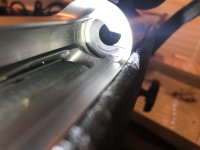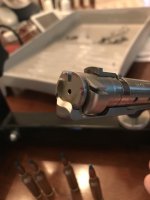This is a follow-up to a earlier post I made about a warranty replacement I received from Winchester/Browning and some questions I had concerning its milling. I actually took that rifle to a gunsmith who pointed out a bigger issue of the bolt face contacting the tenon of the barrel and that accuracy would suffer.
I sent the rifle back and requested that if it were to be replaced that they check for function and accuracy of the new rifle. A little less than a month later I received a replacement rifle. The serial number denotes it to be 10 rifles apart from the one I sent in. Unfortunately, the rifle exhibits the same exact issues as the last one and am not aware if the service center shot it for accuracy. Not sure if I'm making something of nothing or if this is a real issue. From what I have read, it seems that the headspace is not correct, but can't find specific examples of this with another model 70. I have attached a couple of pictures to show my concern. If anybody has any insight or suggestions, I'm all ears. I really like this rifle model, but for this price point, I feel it should be better and perhaps it's just a bad run. Not sure how to move forward.


I sent the rifle back and requested that if it were to be replaced that they check for function and accuracy of the new rifle. A little less than a month later I received a replacement rifle. The serial number denotes it to be 10 rifles apart from the one I sent in. Unfortunately, the rifle exhibits the same exact issues as the last one and am not aware if the service center shot it for accuracy. Not sure if I'm making something of nothing or if this is a real issue. From what I have read, it seems that the headspace is not correct, but can't find specific examples of this with another model 70. I have attached a couple of pictures to show my concern. If anybody has any insight or suggestions, I'm all ears. I really like this rifle model, but for this price point, I feel it should be better and perhaps it's just a bad run. Not sure how to move forward.


Last edited:
